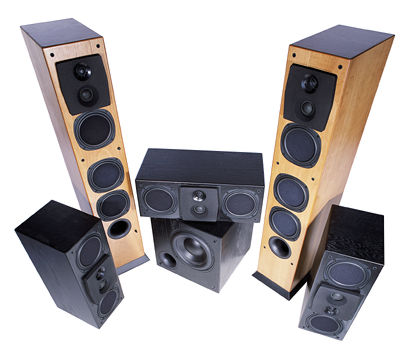Phase Technology Premier Collection surround speaker system

Phase Technology, founded by Bill Hecht more than 40 years ago, isn't new to this game. When son Ken points to a unique design feature or two, he simultaneously rattles off patent numbers as casually as you and I might recall our children's ages. Why not? Phase Tech proudly holds patents for the soft-dome technology and for the flat-piston woofer, both of which can be found in the PC series.
A close inspection of the woofers of the Phase Technology PC 9.1 main and PC 3.1 center/surround speaker might lead you to conclude that they look a bit flat. That's because they are, at least when viewed from the front. Remove the drivers from their cabinet and your confusion is likely to grow. Nestled in more or less conventional metal baskets, these are cones of a different flavor. Imagine the funnel shape of a conventional cone, filled with a very lightweight material so that its face is flat. The driver's motion is still driven by a voice-coil at the business end, but Phase Tech maintains that their flat-piston designs are free from some of the breakup modes caused by the nonlinear motion of conventional cones.
Both the PC 9.1 and PC 3.1 feature a 1-inch soft-dome tweeter and 11/2-inch soft-dome midrange driver, surrounded by a thick blanket of Unicell foam intended to curb cabinet diffraction. The tweeter can actually be angled by the customer to aim up, down, straight ahead, or anywhere between. I ran them pointing straight ahead. Each PC 9.1 main also contains three 61/2-inch flat-piston woofers. The two bottom drivers covered the bass range, while very nearfield listening (as in ear to speaker) revealed that the third woofer driver extended into the midrange. Below the woofers but still about a foot above the floor is a very large port flared inside and out. At that height, the effect of any bass coupling between floor and port should be minimal.
The PC 3.1, used here for center and surrounds, has only two of the 61/2-inch drivers and a much smaller rear-firing port. The midrange and tweeter are on their own separate baffle, so converting a PC 3.1 for horizontal placement as a center speaker while maintaining a vertical orientation of the tweeter-midrange baffle simply involves removing four Allen-head screws and rotating the speaker array 90°.
Once I was satisfied with the 9.1s' positions, the spikes that Phase Tech provides were very easy to install. And the nickel-sized floor protectors made protecting my ceramic tile floor a breeze.
The 3.1 and 9.1 (and the PC sub) use gold-plated knurled knobs for speaker terminals instead of tried and true plastic hex nuts. Okay, they're chic and sexy, and Hecht, they probably looked good on the drawing board, too—but I lost skin trying to tighten down on my spades. Biwiring the 9.1 (the 3.1 can't be) was even more difficult, but I pursued it nonetheless. It didn't help that the 9.1's dual speaker posts are inset at an angle in tight plastic quarters that would comfort only a vacationing sardine.
The PC subwoofer uses an internal 300W amp to drive its 10-inch woofer, and features a large port below and to the side of the driver. It offers the usual host of subwoofer features, including low-level (RCA) and high-level (speaker) inputs and a phase switch. The 24dB/octave, lowpass crossover can be set to any frequency from 40 to 110Hz; it can also be bypassed, if you use the crossover in your surround processor or receiver. The most common crossover point, 80Hz, is clearly marked at high noon. Another knob allows you to set the sub's volume.
The documentation included with this system was a clear case of one size not fitting all. While providing helpful advice on speaker placement for 2- and multichannel setups, mono or stereo subs, spikes, biwiring, and even cabinet care, the owner's manual comes up woefully short on information specific to any particular PC model.
Phased In
I oriented the PC 3.1 surrounds vertically on 24-inch Standesign speaker stands, which allowed one of the woofers and the entire midrange-tweeter array to clear the back of my listening couch. The speakers were about 6 feet behind me and 7 feet from the wall behind them, angled in slightly toward the center position, a setup that helps maintain a balance between channels for listeners seated off-center.
The horizontally oriented PC 3.1 center sat on a pair of the same stands, which placed its tweeter a few inches below my ears. I placed both PC subs in the same location usually occupied by an 18-inch Velodyne: slightly to the left of the right 9.1, their backs about 6 inches from the wall behind them.
The PC 9.1s were set up with their tweeters about 9 feet apart, angled in slightly toward the sweet spot, and, after break-in and some subtle repositioning, spiked and placed on the provided floor protectors. This placed my ears below the tweeters, which were set to fire straight ahead. Because Phase Tech lets you angle the tweeters up or down, I tried aiming them down a bit, but found I preferred the original straight-ahead presentation in my more lively room.
The Phase Techs needed a month of break-in, which seems like a lot but is fairly typical for a dynamic speaker. Woofers loosen up, tweeters shed some of their edge, and the listener becomes more accustomed to something new. The 9.1s were revealing of amplifier choices as well. While I broke them in with the Krell Theater Amplifier Standard power amp I reviewed in January, I ended up trying—and staying with—the Sunfire Cinema Grand Signature. In addition, biwiring the 9.1s' tweeters and midranges with the Sunfire's current outputs, and the woofers with the Sunfire's voltage output, proved the best solution. (I've also done this with the MartinLogan Prodigys, with great results.)





























































